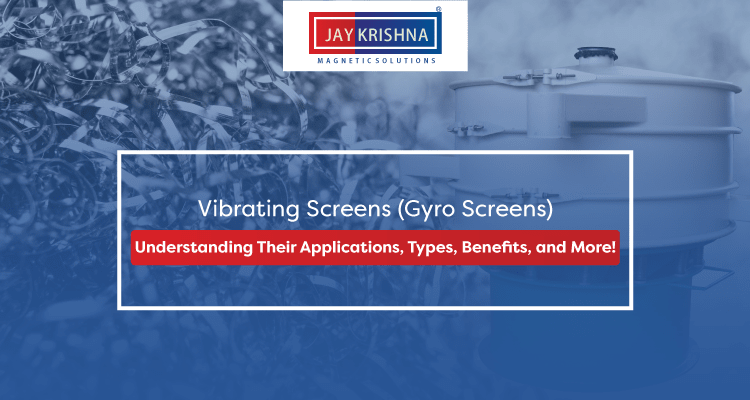Vibrating Screens (Gyro Screens): Understanding Their Applications, Types, Benefits, and More!

Vibrating screens, also known as gyro screens, are one of the most useful pieces of equipment across many industries such as:
- Mining
- Aggregate
- Recycling
- Food processing
- Pharmaceutical
With the growing demand for divergent screening applications, vibrating screens play a pivotal role in the efficient separation of materials as per size for further processing.
Let’s understand what these screens are, their working, types, applications, benefits, and more.
What are Vibrating Screens and How Do They Work?
Vibrating screens are mechanical screening machines that vibrate to separate materials of varying sizes.
The material is fed on an inclined screen deck with openings that allow smaller particles to pass through while larger ones move over the deck.
The vibrating action is generated by exciters that transmit vibration to the screen deck causing the material to separate and travel over the deck in a conveying motion until reaching the end discharge.
Based on the application, vibrating screens can have single or multi-deck screen panels for progressive levels of screening.
Major Applications of Vibrating Screens
Vibrating screens have a wide range of applications across industries.
Mining industry – They are used to separate ores and minerals by size for further processing.
Aggregate industry– Vibrating screens help to classify gravels, crushed rocks, sand, and silts for construction applications.
Recycling industry– They use these screens to separate metals, plastics, paper, and glass.
Food and Pharmaceutical industry– These two processors use vibrating screens for grading and sifting powders, grains, and other ingredients.
Overall, vibrating screens provide efficient, precision screening for both wet and dry applications.
Different Types of Vibrating Screens
There are different types of vibrating screens tailored to suit various applications:
1. Inclined vibrating screens – They are the most commonly used type with an angled screen surface for material flow.
2. Horizontal vibrating screens – They offer high-capacity screening and suit heavy feed materials like coal, sand, gravel, and crushed stones.
3. Circular motion vibrating screens – They operate with an oscillating circular movement to achieve high precision screening even for fine materials.
4. Linear motion vibrating screens – They work with linear oscillating motion and suit medium to fine screening.
5. Banana screens – These are curved vibrating screens for grading larger volumes with multiple screening zones.
6. High-frequency vibrating screens – These screens are optimal for screening fine, sandy, and sticky particles.
7. Gyratory screens – This type of vibrating screen provides high screening capacity in a compact footprint with their gyratory gyrating motions.
Key Benefits of Vibrating Screens
Vibrating screens offer unmatched screening performance with benefits like:
- High screening efficiency even for small and fine materials
- Large screening capacity from compact equipment
- Low operating costs with little energy consumption
- Durable structure for longevity and minimal downtimes
- Low maintenance requirements with easy wear part replacements
- Wide range of screen sizes, decks, capacities, and customizations
- Enhanced safety features as per industry standards
- Smooth material flow and conveyance
Conclusion
Vibrating screens are indispensable assets across many industries given their high performance, durability, and operational flexibility.
With ongoing advancements in screen designs, materials, and controls, these screens will continue improving their capability to handle more challenging screening applications in the future.
That said, if you’re looking to invest in Magnetic Separation and Vibratory Equipment, JKMagnetic has built a reputation for providing top-quality products and exceptional service.
We have the expertise and experience in supplying vibrating screens, vibratory feeders, and other specialized equipment to meet all your screening needs and improve your production efficiency.


